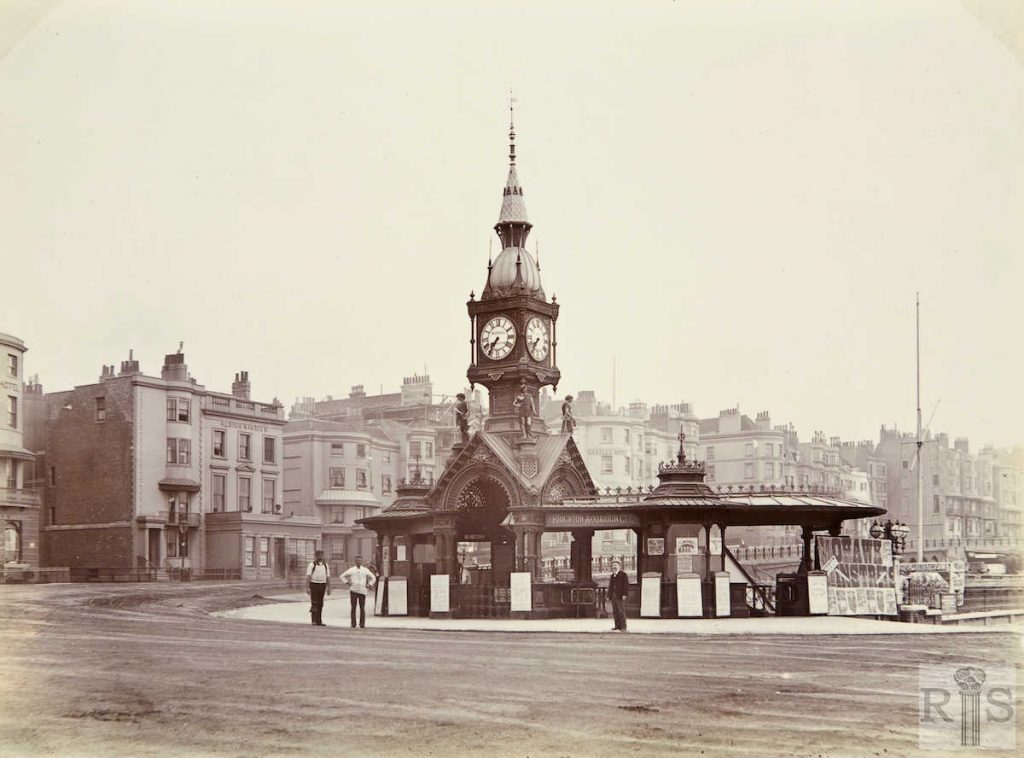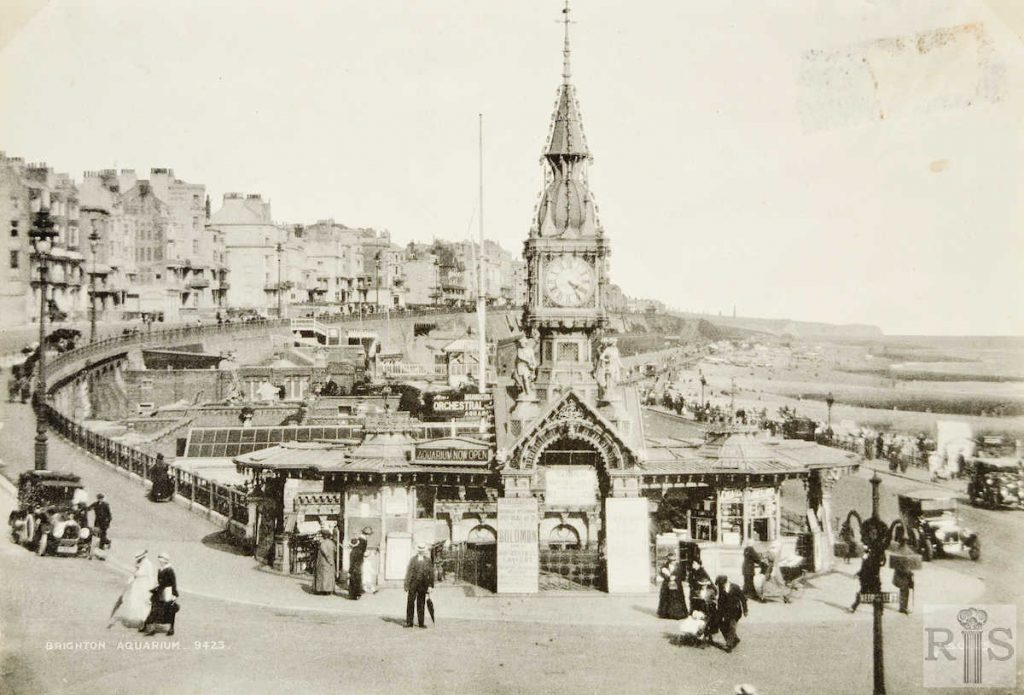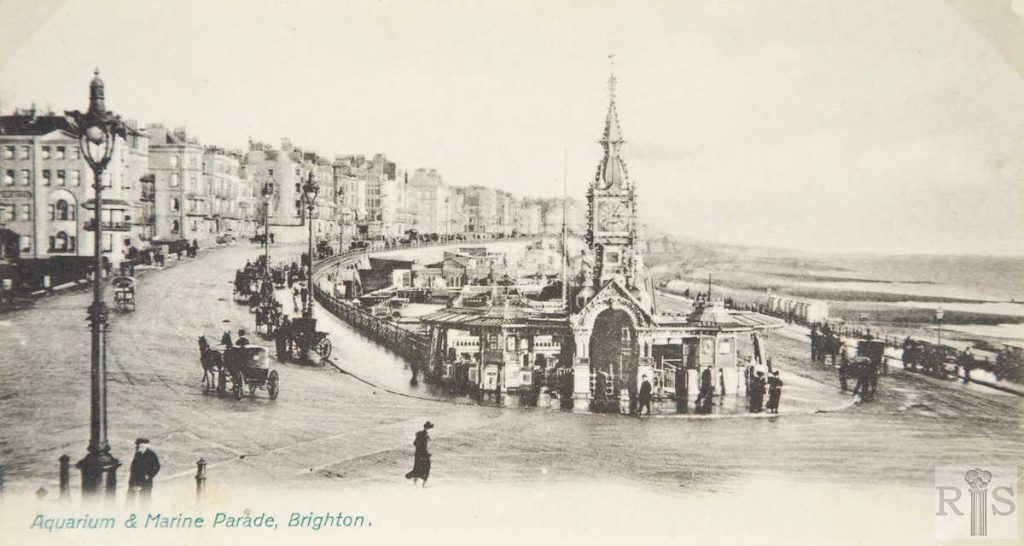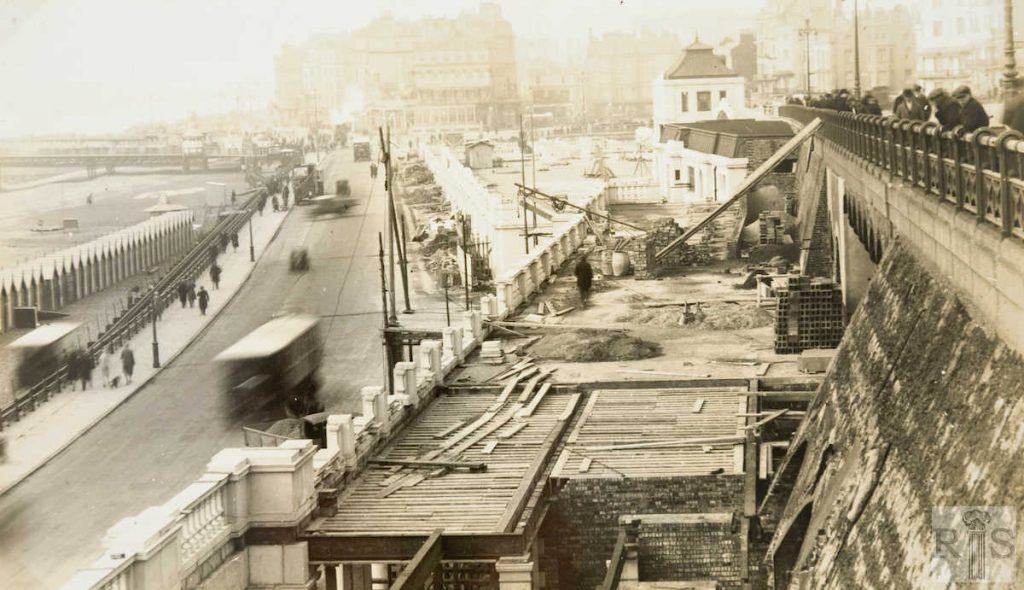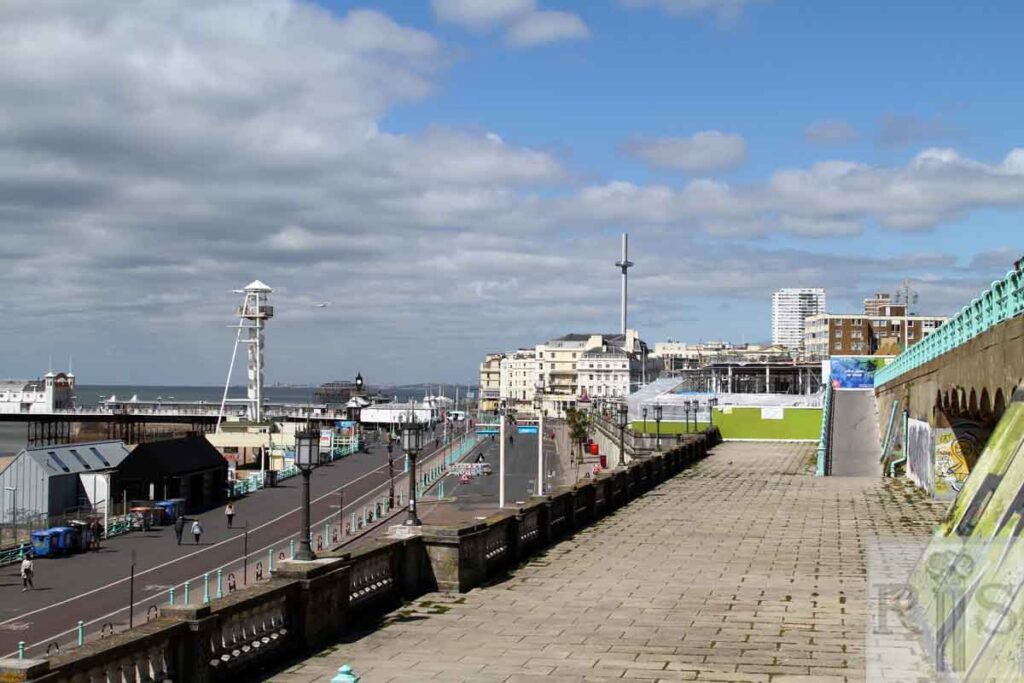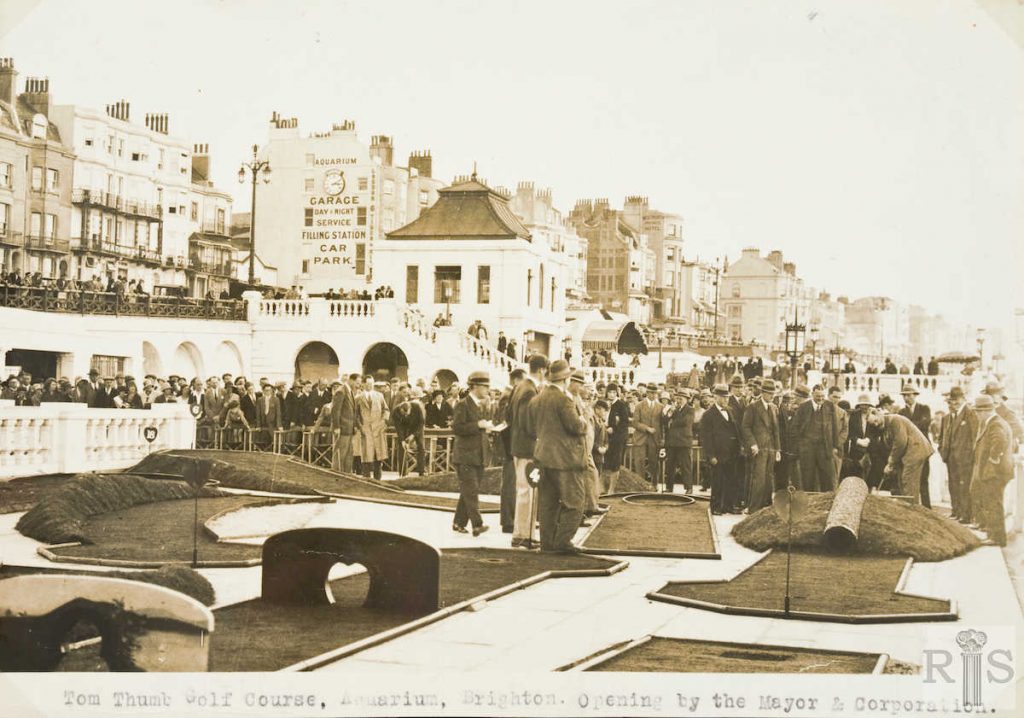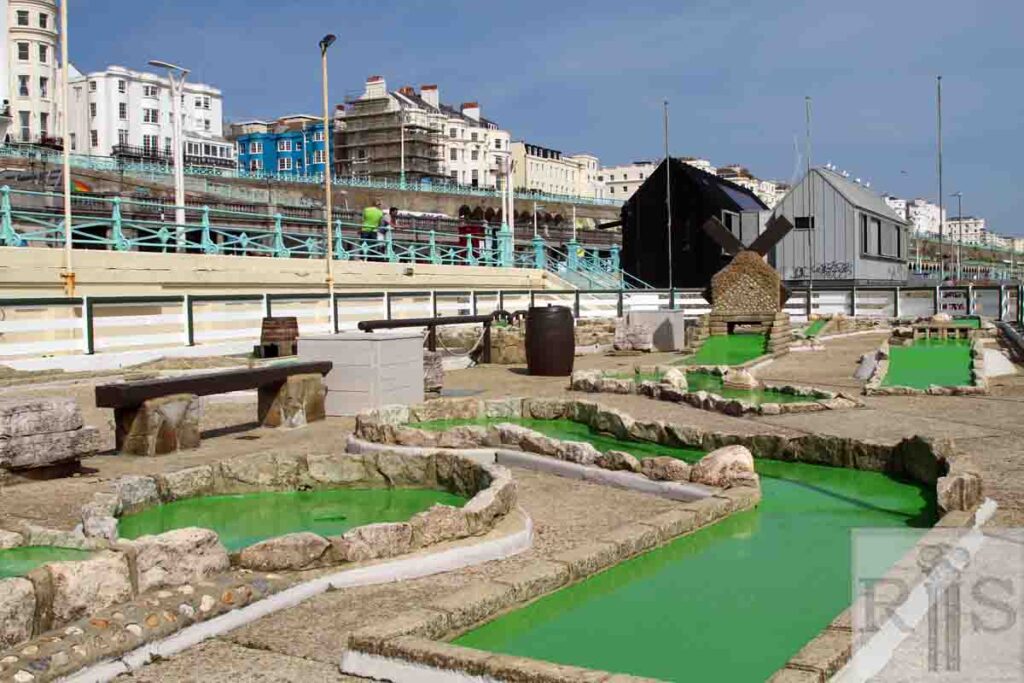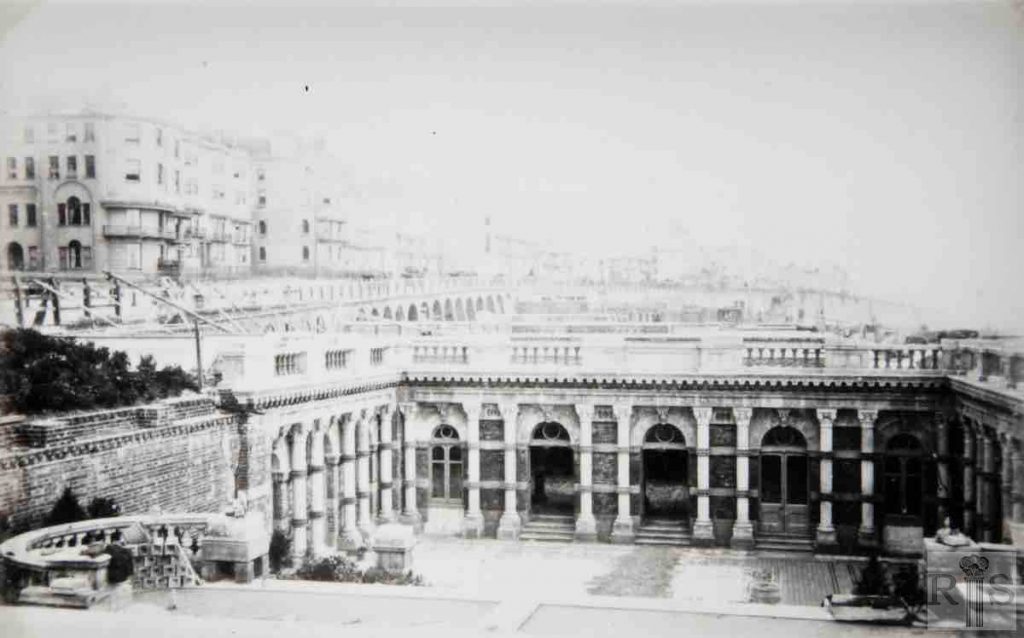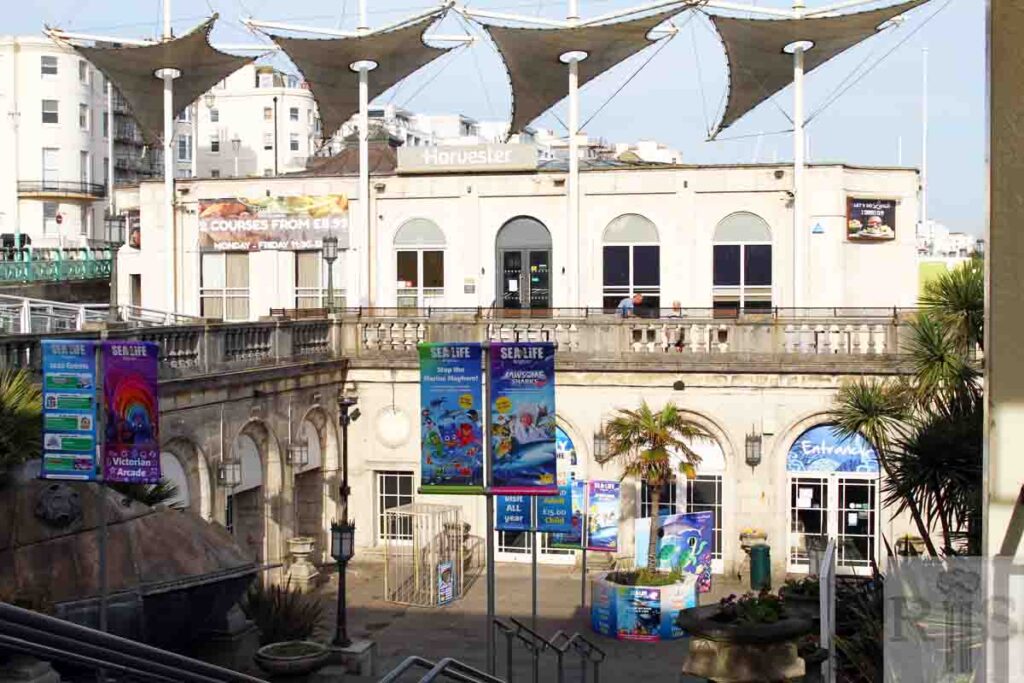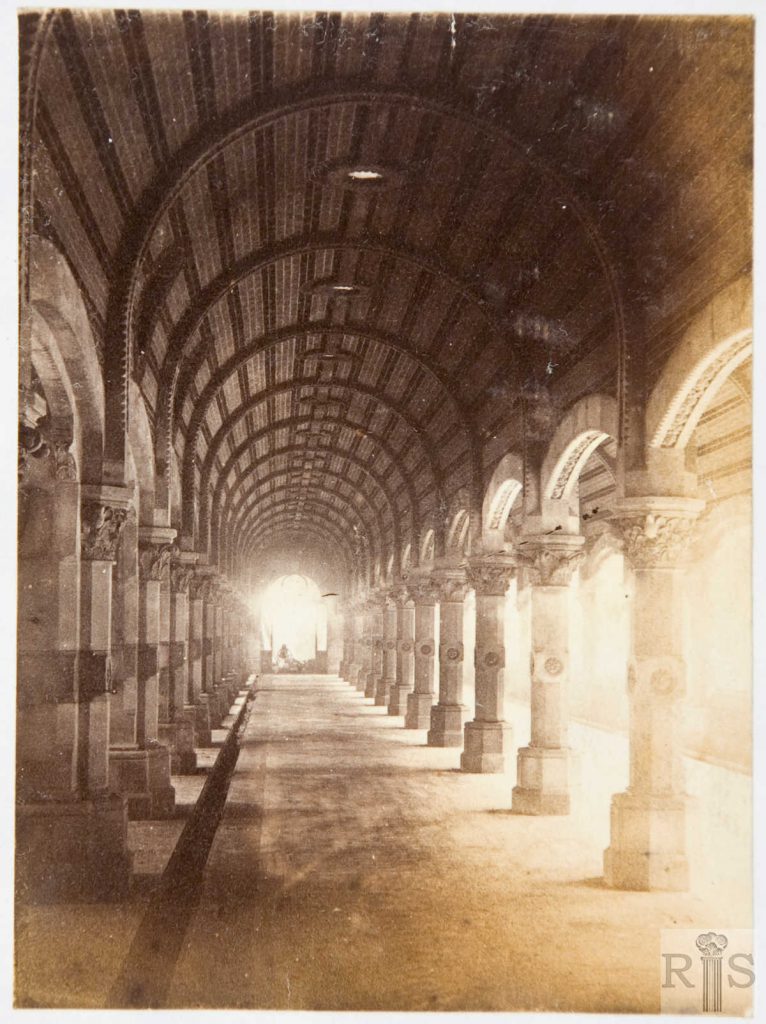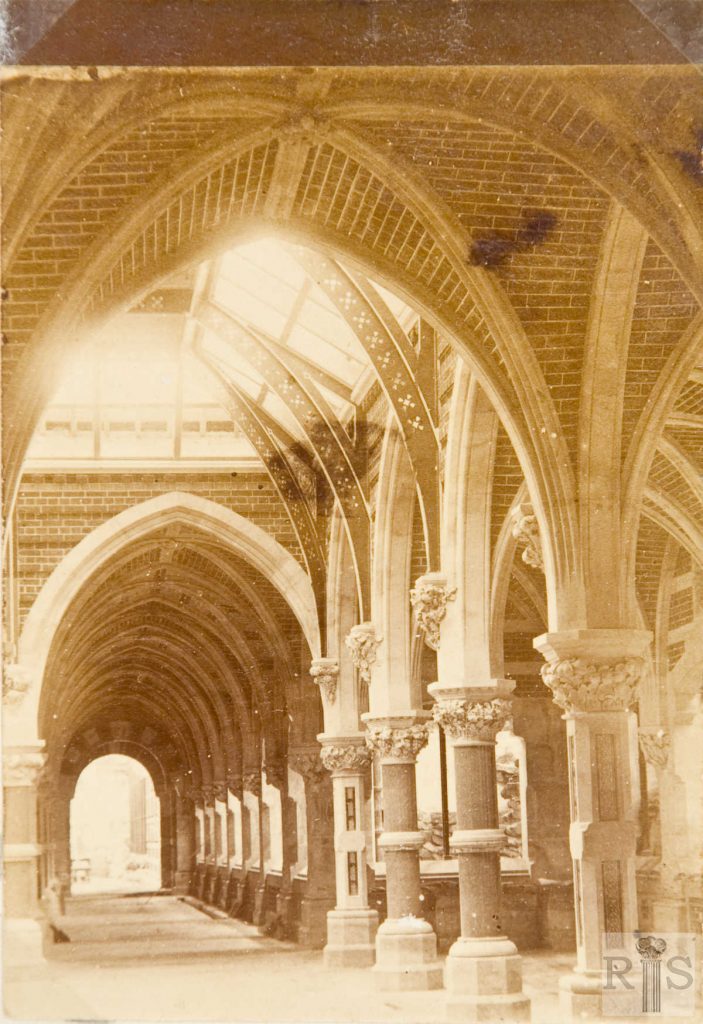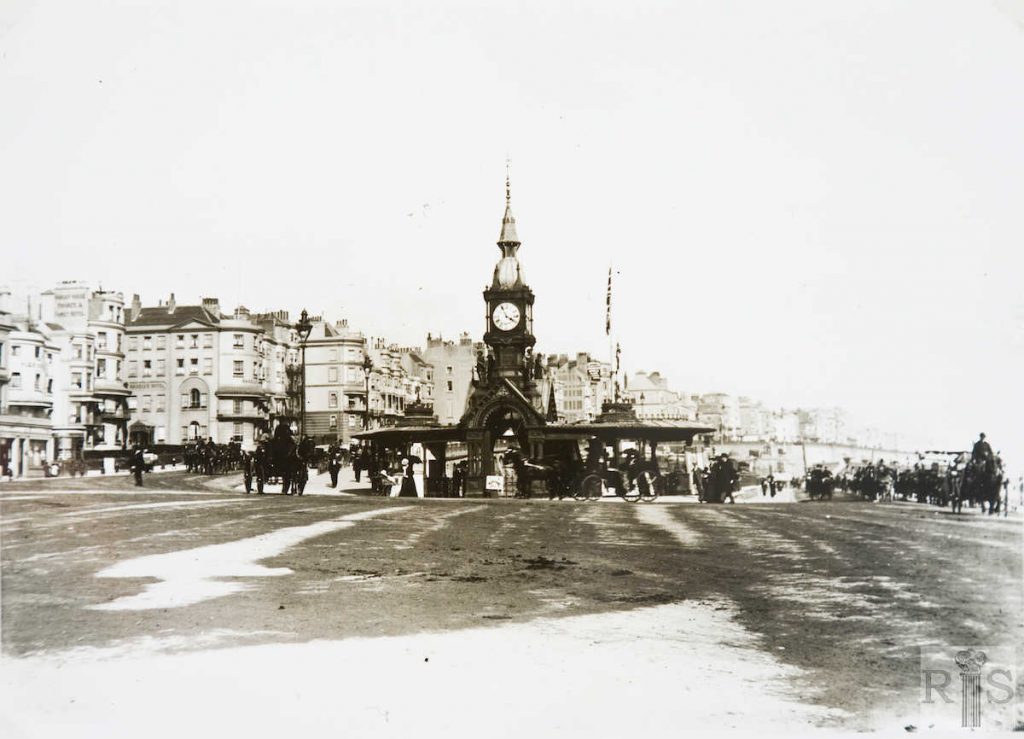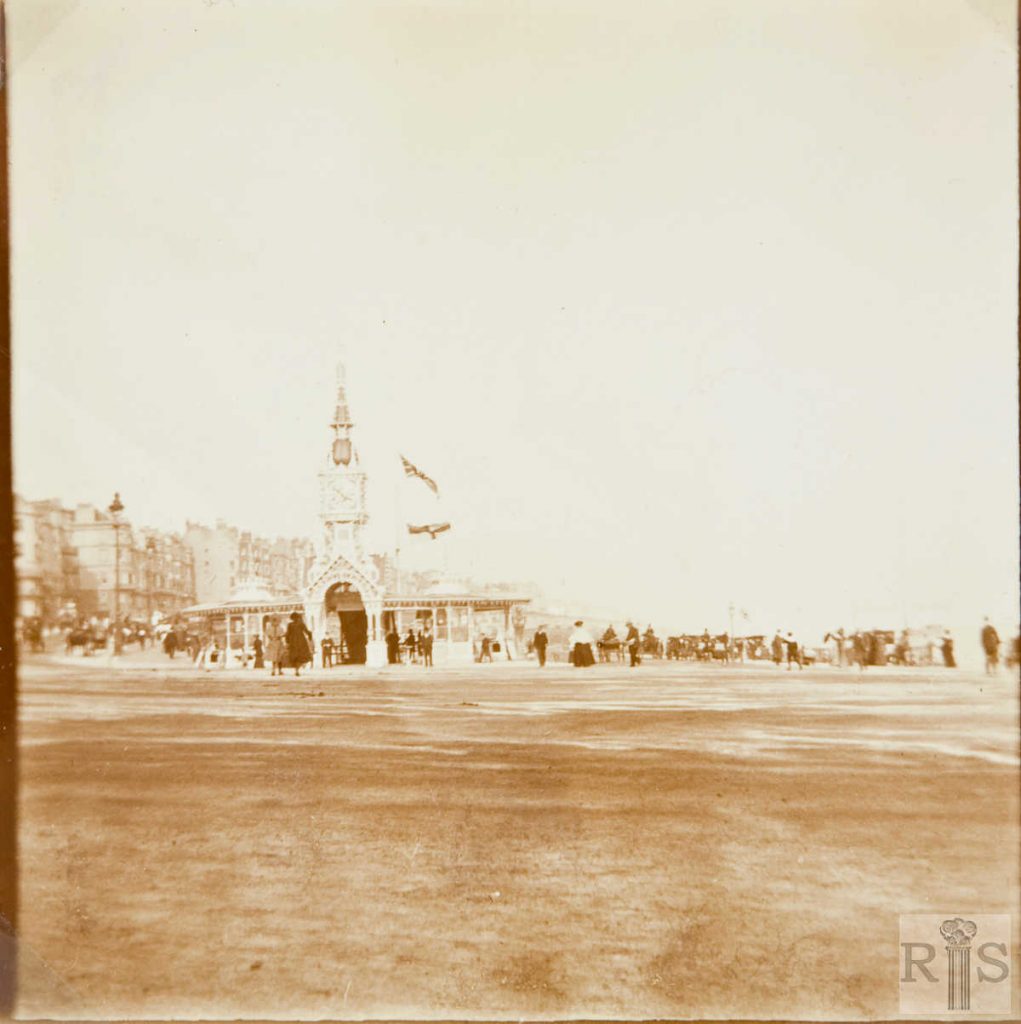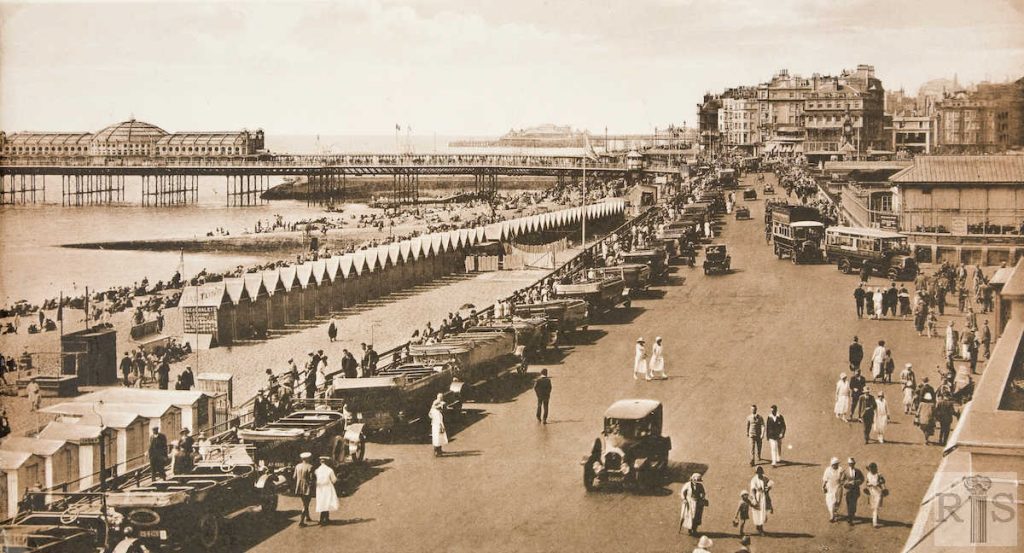
James Gray: Five very early photographs of Brighton Aquarium [jgc_04_115 to jgc_04_119 all on this page], probably taken in the year it was opened – 1872. The photographer was Mr W.H. Mason who described his studio as ‘The Repository of Arts, 108 Kings Road, Brighton’. By 1874 he had passed from the Brighton scene. Additional Information: W.H. Mason came from a family of 8 or more, his father being a printseller in Brighton. jgc_04_117
James Gray: Four more photographs [jgc_04_120 to jgc_04_123] of the Aquarium, inside and out, probably taken soon after the construction of the building. jgc_04_122
2020: The original structure is still there, behind the vegetation and advertising material, but is probably rarely noticed by today’s visitors. (Photographer: David Sears)
James Gray: Four more photographs [jgc_04_124 to jgc_04_127] of the Aquarium, inside and out, probably taken soon after the construction of the building. jgc_04_126
2020: The covered awning seen in the 1870s image is not shown in other images from this time so may have been for some special event. Note the Chain Pier in the background. (Photographer: David Sears)
James Gray: This view appears to show the Aquarium in its final stages of construction, as work can be seen in progress at the top background. If this surmise is correct the photograph probably dates from 1872. jgc_04_128
2020: This is a black and white duplicate of the sepia print shown in jgc_04_117 above. The ornate entrance steps and portico were clearly popular with local photographers. (Photographer: David Sears)
James Gray: This small, clear view dates from 1904. jgc_04_133
James Gray: The Marine Parade railings tell us that these photographs [see also jgc_04_130 below] must date from 1880, or a little later. They afford a good view of the ornamental lamp standard, which was removed when the seafront lighting changed from gas to electricity in 1893. jgc_04_129
James Gray: [Top row left] Another view. jgc_04_141
James Gray: [Top row right] No comment. jgc_04_136
James Gray: [2nd row left] Exact period unknown. Obviously after 1911 and probably about the time of the 1914-18 War as there are few young men to be seen. Additional Information: Poster shows concert by Solomon on Saturday July 31 – this is 1915. jgc_04_096
James Gray: [2nd row right} [See caption for jgc_04_129 above.] jgc_04_130
James Gray: [3rd row left] No comment. jgc_04_134
James Gray: [3rd row right] There are several clues to the age of this photograph. The electric lamp standard, the Chain Pier, Madeira Terrace partly built, and the hoarding masking the skeleton of the new Palace Pier limit the period between the years mentioned [1893-1896]. jgc_04_132
2020: The old images (jgc_04_136 and 141) look north-east from Madeira Drive, across the entrance to the Aquarium, to the hotels on the other side of Marine Parade. The modern image shows the entrance to the new Aquarium which opened in 1929, now trading as Sea Life Brighton. The streets are empty and the attraction itself is closed due to the coronavirus pandemic. (Photographer: David Sears)
James Gray: A very fine view of the eastern sea front. In this photograph can be seen the Aquarium, Marine Parade and the terraces as far as Kemp Town, and part of the Chain Pier. The Palace Pier, of course, had yet to be built. There are no clues to the date of this photograph, which could have been taken in the late 1870s or the 1880s. Additional Information: Fine lampstandard, goat cart. jgc_04_131
James Gray: The old aquarium was opened in 1872. At first it prospered, but its fortunes declined and it was sold to the Corporation for £30,000 in 1901. As the years passed it fell into greater dilapidation and was demolished in 1927. Rebuilding commenced the next year, and the present Aquarium was opened in June 1929.
James Gray: Commencement of the demolition at the eastern end, in the early part of 1927. The building just below the crowd of spectators was the Ex-Service Men’s Club. jgc_04_179
2020: The 1927 photograph is one of the few images looking west past the aquarium to the Royal Albion Hotel and beyond. The beach huts on the left (south) of Madeira Drive have long since disappeared. Madeira Drive itself, however, is as empty in 2020 as it was in 1927, being closed to cars and buses, but open to pedestrians and cyclists, following a Brighton and Hove City Council initiative to reduce car use. (Photographer: David Sears)
James Gray: The last phase, March 1929. Beyond the desolate clock tower, now in course of removal, can be seen the new buildings to be opened three months later. Note the different appearance of the lamp standards. The change from single to double globes was made in 1928. jgc_04_180
James Gray: View of the old building shortly before demolition began in 1927. Note on the left the arches over which Marine Parade was widened in 1871. Additional Information: Posters read: Your last opportunity – World’s biggest and most famous aquarium before reconstruction at a cost of nearly £100,000. jgc_04_182
James Gray: The new Sun Terrace under construction on 8 December 1928. jgc_04_183
James Gray: Demolition of the ornate entrance containing the pay-boxes and supporting the clock tower (seen on other pages) during the winter of 1928/29. The statues seem to have weathered well during their 50 odd years’ exposure to the elements. Note the advertisement for the Southdown Holiday Tours for 1928, and the elegant light globes introduced for the first time in May 1928. jgc_04_181
James Gray: At a lower level in the new building was the Prince’s Hall, shown here. For a few years after its opening it was used for stage shows, concert parties and the like. Then, both before and after the Second World War, it was a most successful and popular Dance Hall. The present Dolphinarium is now located approximately on this site. jgc_04_187
2020: See caption for jgc_04_182 above. (Photographer: David Sears)
James Gray: 21 February 1929. The suspension chains of the old Chain Pier passed beneath the eight small arches, 54 feet into the cliff below Marine Parade, where they were secured by an iron plate weighing nearly 3 tons. jgc_04_184
James Gray: Another view of the Old Chain Pier buildings which were removed in 1927. The large house in the centre was originally used as a Saloon or reading room, and became very popular during the early days of the Pier. Later, for many years prior to the Pier’s destruction, it was known as Snelling’s Bazaar. Mr Snelling was Secretary of the Pier Company for nearly 30 years. The first Pier Master occupied the cottage West of the Saloon, known later on as Beach Lodge. jgc_05_123
James Gray: In 1930, the year after the reconstruction building was opened, other ancillary attractions were introduced. One of these was the Tom Thumb Golf Course installed on what was later to be the Sun Terrace. The photograph shows the opening; the Mayor, Councillor H. Wilfred Aldrich, is standing facing the camera with his right hand in his pocket, with the Town Clerk, Mr. J H Rothwell, on his immediate right. Additional Information: Aquarium Garage now flats. jgc_04_186
James Gray: This view shows works still proceeding on the Aquarium building, probably in late 1871 or early 1872. The official opening took place on 10 August 1872. Additional Information: Photographer: Philippe Garner. jgc_05_007
2020: Eugenius Birch’s Aquarium building was modified by borough surveyor David Edwards in the late 1920s. The original structure and layout of the steps and entrance can still be seen today behind the modern advertising material. East of the Sea Life building today, the distinctive modern awnings belong to The Harvester pub and restaurant. (Photographer: David Sears)
James Gray: [See caption for jgc_04_117 at top of page.] jgc_04_115, 116, 118 and 119
James Gray: Four more photographs of the Aquarium, inside and out, probably taken soon after the construction of the building. jgc_04_120
James Gray: [See caption for jgc_04_120 above.] jgc_04_121, 123, 124, 125 and 127
James Gray: No comment. jgc_04_138
James Gray: A very fine photograph taken by Frith’s of Reigate, in 1896. Among several interesting features are the Preston Park bus, the coffee stall provided by Gillams of Church Street, and the contrast between the recently erected electric light standards on Marine Parade and the small gas lamps on Madeira Drive. Additional Information: Uncluttered streets and pavements. jgc_04_139
James Gray: This small photograph is of just a few years later, in the early 1900s, and shows little change apart from the swept crossing. Both show the very dirty roadways of this period. jgc_04_140
James Gray: This rather indistinct photograph showing also Marine Parade and Madeira Drive was taken from the Royal Pavilion Hotel. It looks as if the period is between 1890 and 1896. jgc_04_149
James Gray: Three photographs of the old Aquarium, all dating from the period 1900-1914 [see also jgc_04_158 and 159]. jgc_04_157
James Gray: Another view showing the roadway free from traffic. jgc_04_158
James Gray: This one is interesting as showing the original façade of the Royal Albion Hotel, and the side of the Royal York. jgc_04_159
James Gray: The changing scene. The transition from horse drawn traffic to motor transport. This photograph dates from 1900-1910, while the next one [jgc_04_161] was taken in 1927 shortly before demolition began. jgc_04_160
James Gray: Immediately prior to the demolition of the old Aquarium. jgc_04_163
James Gray: A few years later probably about 1900. jgc_04_164
James Gray: The new Aquarium as it was on the morning of 12 June 1929, the day on which it was officially opened by the late Duke of Kent. jgc_04_165
James Gray: Crowds milling around the old Aquarium and Volk’s Electric Railway. Note the congestion in Madeira Drive, due to Southdown buses unloading on one side and motor coaches on the other. jgc_04_166
James Gray: Two photographs taken within a year of each other [see also jgc_04_170 on the Maderia Drive page]. The view of the Aquarium and central island is dated 1926. At this period Southdown buses terminated in Madeira Drive alongside the Aquarium where they caused considerable traffic congestion until moved to Pool Valley in 1929 The No. 8 bus ran up Montpelier Road and finished at Seven Dials. jgc_04_169
James Gray: View looking east over the Aquarium. Additional Information: Aquarium dancing. jgc_04_188
James Gray: During the 1930 series of Test Matches between England and Australia, this score board was erected on the Sun Terrace, by Johnnie Walker Whisky. Very large crowds were attracted to this unique means of following the play then in progress. Phoned information was manipulated on the boards, thus giving a ball-by-ball reproduction of the progress of the game only minutes behind the actual play. This photograph gives the close of play, fourth Test at Manchester, 25 July 1930. ‘The supreme attraction was the gigantic score board on the Aquarium Terrace which, by ingenious mechanism, showed ball by ball what was happening in the epic Test match at Lord’s between England and Australia. The white ball could be seen in flight wherever it was in play, and the fall of the redoubtable Don Bradman’s wicket was the signal for prolonged cheering. It is the nearest approach to television of a cricket match that has yet been secured’. Brighton Gazette August 1930. jgc_04_189
James Gray: [See caption for jgc_04_189 above.] jgc_04_190
James Gray: The old aquarium was opened in 1872. At first it prospered, but its fortunes declined and it was sold to the Corporation for £30,000 in 1901. As the years passed it fell into greater dilapidation and was demolished in 1927. Rebuilding commenced the next year, and the present Aquarium was opened in June 1929. At this period, the eastern end of the Aquarium was the terminus of the Southdown buses, two of which, with solid tyres, are shown below.












